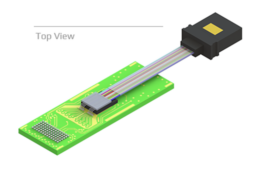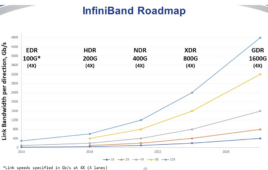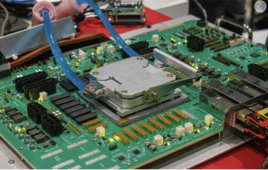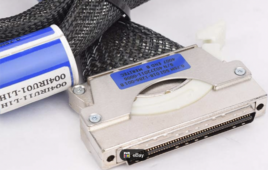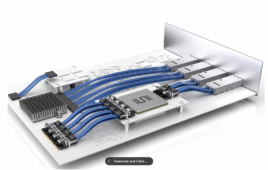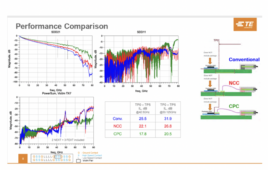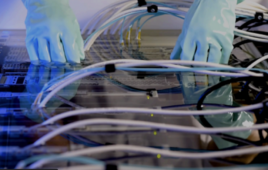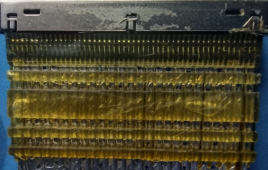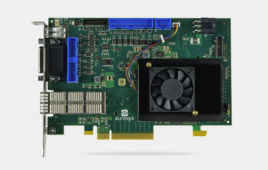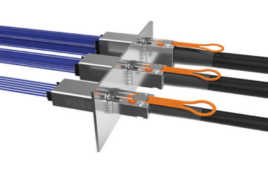Inside-the-box copper connector and cable IO-Link standards for data centers have been a significant focus of systems product development, particularly within consortia and industry standards groups. Some recent examples are internal 400G and 800G PECFF Top-of-Board, Ethernet, CXL, and the PCIe use of SFF TA 1002/1020 connectors. Other examples include twin-axial cables for memory, storage, […]
Pluggable IO interface technology driving 224G PAM4 cable and connector developments
In this article, we’ll discuss the recent 200+G PAM4 per-lane interconnect developments supported by various consortia, standards bodies, and new product announcements. The latest 2023 Ethernet Alliance Roadmap shows the demand for 200+G per-lane pluggable modules, connectors, copper, and optical cable products by 2025. Based on their chart below and the interface roadmap, several different lane-count versions […]
How high pin-count socket connectors are supporting new processor-chip applications
Datacenter server processor chips have proven valuable as pluggable and removable devices for the socket connectors mounted to a server’s main PCB board. However, the number of contacts per socket connector has dramatically risen over the last few years. New chips offer 3000 to 5000 or more contact pads per flip chip. Typically, the socket […]
How the terabit class of pluggable cables and connectors is advancing
The world of gigabits began some 25 years ago, with a progression of interface lanes and links — from 100G and 200G to 400G and then 800G using IO standard and proprietary connectors and cables. Believe it or not, gigabit lanes were first used in 1999. Today, we’re entering the terabit phase with interface links […]
How new USB4.2 80G cable links will support cost-effective connectivity
The USB Promoter Group recently announced the November release of the USB4 Version 2.0 specification, a significant update to enable up to 80 Gbps of data performance over the USB Type-C cable and connector. The USB Type-C and USB Power Delivery (USB PD) specifications will also be updated to enable this higher level of data […]
Will internal IO copper cables for data centers become standardized?
Data-center passive DAC external cables have been standardized and interoperable for decades. However, the mating, inside-the-box cables have yet to be fully standardized. In general, inside-the-box IO interface interconnections have been a competitive value point for those OEMs and suppliers that offer quality options. Providing reliable connectors and twin-axial cables configured in an ideal layout […]
New developments in 212+G per-lane data-center connectors and cables
Several deep-packet inspection chips and test instrumentation applications are using next-generation speed-rate IO application-specific integrated circuit (ASIC) chips. These chips combine several circuits in one and are customized for a particular use. This is different than what the current server and switch markets are typically using. These developers are experienced with the 200+ per lane […]
How QSFP-DD and OSFP Loopback modules are supporting multiple IO interfaces
IO Loopbacks connect digital data streams to their source without purposeful processing or modification. This serves as a diagnostic test for a device and other nodes in the network infrastructure. The return signal is compared with the transmitted signal. For several generations of electronic equipment, using a short cable assembly, molded very-high-density cable interconnect (VHDCI), […]
Driving standards: The latest liquid-cooling cables and connectors for data centers
Passive and active direct liquid cooling for modules and chassis immersion implementations are becoming more commonly used to cool high-wattage devices — such as graphics processing units (GPUs) and switch application-specific integrated circuits (ASICs). This seems to be driving an expanding fluid connector and cable market with higher-volume units as applications now include hyperscaler and […]
Wire and fiber optic geometries offer high-speed cable transmission options
The latest high-speed transmission cables are benefitting from the use of optic-fiber and copper wire options, which are offering unique form factors and customizable solutions. Typically, data-transmission copper wire and optical-fiber conductors are round or cylindrical. The addition of silver plating on the copper conductor facilitates the high-frequency electrical transmission path. Fiber conductors are foundry […]
How the digital-interface standards for cables and connectors are changing
CoaXPress (CXP) is a popular, digital-interface standard developed for high-speed transmission of data, videos, and still images. This interface was introduced in 2008 and has been used in industrial automation for years, with advanced machine vision and robotics applications following suit. It has been driven by reliability and simplicity, which includes its cables and connectors. […]
How system fabric I/O interface cables and connectors are evolving
Newer fabric network input/output (I/O) cables and connectors support higher speeds, reduce latency, and support the latest interfaces — including the IEEE-802.3df Ethernet 200G per-lane specification project and modified versions, such as the RoCE and iWARP Ethernet. Other new cable and connector developments are working to include standard InfiniBand XDR 200G and modified versions, such […]
How HDD and controller connectors and internal cables are evolving
NVMe Hard Disk Drives (HDDs) are a new storage system product family currently going through development and validation. It’s expected that some of these products will be released in 2023 or 2024. HDDs store memory on a spinning disk and are slower than solid-state drives (SSDs). So, why new HDDs? The new devices are said […]
How accelerator IO interface connectors and cables offer more options
Accelerator I/O connectors and cables provide secure, electrical contact and transmission for high-speed data. These devices typically make up one of the largest unit percentages of data-center equipment in terms of use and assembly. This is particularly true compared to top-of-rack (TOR) switching fabric network interface cables, such as Ethernet or InfiniBand. TOR switching is […]
PCIe Gen 1 thru 7 internal cables
PCIe interface signaling and physical layer implementation has usually involved mostly PCBAs and various edge connectors. However, each signaling rate generation and associative connectivity have had standard and non-standard cabling solutions that support a variety of applications and related topologies. Even the older ISA, EISA, PCI, PCI-X interface standards implemented various internal flat cables using […]
How PCIe interface developments have changed and advanced
By Ed Cady, contributing editor Peripheral component interconnect express, or PCIe, has become the interface standard for connecting high-speed components, such as graphics, memory, and storage. Typically, PCIe interface signaling and physical layer implementation rely on printed circuit board assembly (PCBAs) and edge connectors. Several standardized and non-standardized cabling solutions are available that support a […]
Inside data centers: Cabling considerations for new FibreChannel links
A Fibre Channel (FC) storage area network (SAN) and Inter-Switch-Link (ISL) interfaces are an important part of modern data-center systems, including in hyperscale or enterprise ones. FC SAN is a high-speed network that connects servers and storage devices, and the Inter Switch-Link joins and maintains the traffic flow between switches and routers. A benefit to […]
How cable technology is evolving to meet high-performance networking
Persistent memory has become one key technology for the cloud as speed, efficiency, and volume at data centers advance. In high-performance computing, the cloud often requires data to be moved between multiple physical systems. Data may also be replicated for redundancy and protection, or it can be split across physical systems for performance. High-performance networking […]
How cable technology is evolving to meet high-performance networking
Persistent memory has become one key technology for the cloud as speed, efficiency, and volume at data centers advance. In high-performance computing, the cloud often requires data to be moved between multiple physical systems. Data may also be replicated for redundancy and protection, or it can be split across physical systems for performance. High-performance networking […]
Considerations for new datacenter, inside-the-box, twinaxial IO cables
New 50G, 100G, and 200G per lane internal copper twinaxial cable assembly solutions solve emerging DC/Cloud inside-the-box interconnect problems and new technology changes. Internal cable applications and high volume usages have also rapidly increased. For each new speed rate internal cable assembly product, design teams must closely review the detailed specifications for components, processes, and […]
IEEE 802.3 Ethernet next-gen study group holds successful webinar
IEEE 802.3’s progressing “Moving Beyond 400Gb/s Ethernet Study” group members held a highly interactive and successful video webinar in conjunction with Lightwave with an excellent question and answer sections. This was a 100+ page three-hour rich experience meet up with key observations, data, and current conclusions from various industry leaders. After the recent EA’s TEF, […]
Ethernet Alliance holds a successful Technical Exploration Forum
Ethernet’s Alliance Technical Exploration Forum was a very successful online video conference with an excellent question and answer sections. This was a 150+ page 10 hour rich experience meet up with perspectives of different industry leaders. A key consensus takeaway was: due to currently unattainable SerDes power & cooling practical limits, Co-Packaged Optical interconnects will […]
SFP, SFP-DD, QSFP, QSFP-DD & OSFP Pluggable interconnects – a 2021 update
The 21-year-old Pluggable interconnect family is now being used for new accelerator, AV, camera, machine vision, medical, memory, NVM, and proprietary interface links. New market segment expansion seems likely to continue with link shipments rising and healthy unit forecasting. New higher speed 106G and 112G per lane pluggable products will be coming out this year, […]

